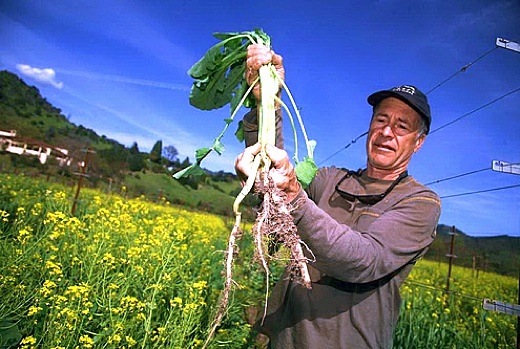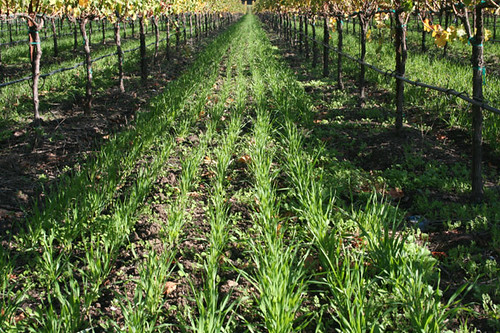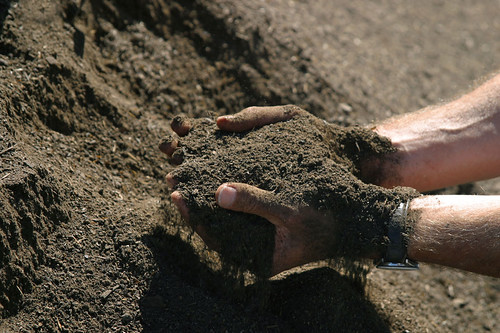By Sven Eberlein on 21 August 2012 for the Daily Kos -
(http://www.dailykos.com/story/2012/08/21/1120065/-Climate-Change-SOS-Soil-is-the-Solution-or-the-most-important-environmental-story-I-ll-ever-write)

Image above: Agronomist Bob Shaffer shows long roots of a mustard plant. The roots carry nutrients and carbon deep into the soil. By composting 620,000 tons San Francisco residents and businesses returned nutrients to local farms and sequestered, or put back into the soil, 18,400 metric tons of CO2. Photo by Larry Strong, courtesy of Recology.
A few months ago I was working on an article about San Francisco's pioneering efforts to become the world's first zero-waste city by 2020.
Chronicling this journey toward a current nation-leading 78 percent waste diversion rate, a major focus of the story was on the city's mandatory composting program that has played a huge role in keeping over a million tons of food scraps, plant trimmings, soiled paper, and other compostable materials from clogging up landfills and releasing methane into the atmosphere.
I was particularly interested in the idea of the food cycle, and it was heartening to see just how far along the City by the Bay has come in closing it: each day 600 tons of sloppy goodness from hundreds of thousands of residents, businesses, and over 5,000 restaurants gets shipped to a local state of the art composting facility, from where it returns to residents’ dinner tables in the form of fresh, organic foods grown by local farmers who use the city’s nutrient-rich compost as fertilizer.
It wasn't until after the story was published that I was alerted to the most remarkable and possibly game-changing discovery about urban compost: its potential to offset 20 percent and perhaps as much as 40 percent of America's carbon emissions!
Please follow me below the light brown dung beetle underneath the tuber curtain to dig a little deeper...
These were his exact words:
That is remarkable and a partial fix for climate change. If everyone did it and if we planted more trees on marginal soils, we could offset 20 percent of America's carbon emissions!He also sent me some photos and descriptions that illustrate how this method has been applied by local farmers who've been planting cover crops with SF compost...

Image above: Cover crops being grown at Chateau Montelena with San Francisco compost. Please note the way the crops are planted between the rows of vines. The 8-foot-wide hallway, between the rows of vines, is previously unused agricultural space, high-quality ag space. Vineyard crews drill holes in the floor of the vineyard and put cover crops seeds in the holes. Then they apply compost made from food scraps collected in San Francisco over the floor of the vineyard. hoto by Larry Strong, courtesy of Recology.
Now, I had heard plenty about planting trees and forests to absorb CO2, but it takes a lot of open land to do that, so if indeed we could use already existing and unused farmland to sequester carbon, that would truly be a win-win situation. Working for one of the most serious (no)-waste management companies in the world, I trusted that Robert wasn't just making this up, but he insisted I didn't take his word for it and connected me with the people who have been studying and working with compost and cover crops for years.
First I got in touch with Fulbright Scholar and former Rodale Institute Research Director, Paul Hepperly. In his research, Dr. Hepperly found that applying food scrap compost to one acre of land can add 12,000 pounds of carbon to the soil in one year, taking it out of the atmosphere, while conventional farming — tilling the land, using commercial fertilizers, etc. — releases 3,700 pounds of carbon dioxide into the atmosphere per acre per year.
In a nutshell, what happens is that these cover crops like mustard, beans, anise, or wild iris grow long roots that carry carbon 14 inches into the soil. The nitrogen-rich urban compost itself also retains carbon, provides carbon to the soil, and helps enable the earth to store carbon.
 |
| Image above: Vineyards in Northern California apply compost made from food scraps to grow cover crops such as mustard and beans. That stimulates microbial activity and helps turn farms into carbon sinks Photo by Larry Strong, courtesy of Recology.
According to Dr. Hepperly, one of the big problems with our present approach to the greenhouse gas issue is a lack of a holistic perspective. While we're trying to find ways to reduce emissions we have not looked at the enormous potential that sequestration of carbon and nitrogen in our soil has for counteracting not only agricultural emissions but the emissions for transportation and industrial sources.
To illustrate this point, all you need to do is look at the current dismal 3% nationwide composting rate. What this means is not only that we're letting 97% of our food scraps needlessly fill up landfills across the U.S. and release methane into the atmosphere, but we're squandering a huge opportunity to use a simple natural food cycle to pull loads of carbon back into the ground. Not to mention the restorative effect of returning carbon and nitrogen to our eroding topsoils and nutritional value to our food. It's full circle!
As amazing as this is, it didn't seem like rocket science to me. I mean, long before industrial agriculture and chemical fertilizers created the illusion of flawlessly chiseled vegetables magically appearing on Walmart shelves, farmers and the general population alike knew that compost is one of the most precious, life-giving resources on earth. My mom, who grew up in a rural area of Southern Germany, has always treated compost like gold. Any amateur gardener covets her food waste like a Momma Bear her cub.
So how did we get to a place where we're throwing away over 97% of all our food waste?
I got some of the answers to this question from Bob Shaffer, an agronomist based in Glen Ellen, CA, who's been compost-consulting with vineyards and farms all over California and Hawaii for many years and who is one of the main liaisons between Recology and the Northern California agricultural community. A former farmer himself, Bob told me that the practice of applying compost to cover crops is not only catching on among small farmers concerned about erosion and producing high mineral value food, but among big players like General Mills eager to restore their soils ravaged from decades of chemical fertilizers.
"We take our most precious land and we raise crops at great cost. We take our best people — well trained farmers, scientists, universities — into a system raising that food. We use chemicals and all that junk to raise it. Then we transport the food 2000 miles — another great cost — and then we cook it and throw much of it away!The problem now, according to Bob, is that while Recology produces about 150,000 cubic yards of compost annually and supplies more than 200 Napa Valley wineries, the demand for this precious resource is getting so high, the dismal 3% national composting rate is causing severe shortages.
If we allow this to go on any longer, not only are we poisoning ourselves with methane, which is a potent greenhouse gas, we fill up our landfills, which we don't have any room for, and we're not getting the most precious thing that we raise, high mineral value food, back into the soil where it belongs. Now that's a full-blown crisis."
- Bob Shaffer
On one hand, this is exciting, as it shows that more and more growers are realizing the great benefits not only to their own soils and crops but their unique position in being part of the solution to climate change. Bob told me that some of the larger Big Ag companies like General Mills are even beginning to produce their own compost by designating entire fields to growing giant grasses like Miscanthus, switchgrass, and Arundo donax that not only sequester carbon in their deep roots but whose cuttings make for great nutrient-rich composting material. "We'll grow our own carbon," he says. It's a win win, because we don't have to transport it, we don't have to buy it, it puts carbon back where it belongs, back into the plant, and we chop the plant, compost it, and composting is the process that stabilizes carbon and nitrogen."
And yet, the scope of composting programs around the country is still so miniscule that we are missing one of the most natural and promising opportunities right before our eyes to sequester huge amounts of CO2 out of the atmosphere.
While San Francisco has led the way in showing what's possible with a mandatory composting program and a state of the art composting facility...
The composting program alone has diverted one million tons of waste from landfill disposal. By reducing methane, a potent greenhouse gas produced in landfills and by sequestering carbon in the topsoil of local farms, the program has created a total carbon dioxide equivalent benefit of more than 305,944 metric tons – equal to offsetting emissions from all vehicles crossing the Bay Bridge for two years (Greenhouse gas offsets based on a protocol set by the Climate Action Reserve)....many municipalities poised to start their own composting programs find themselves running up against not only a perceived "yuckiness" factor among residents but a maze of arcane composting regulations that make it difficult to build new composting facilities. And no surprise, big pharma and producers of chemical fertilizers are lobbying against new facilities.
To all the people involved in municipal composting, this movement to drastically ramp up urban compost production to use as cover crops is the great untold story in the fight against a warming planet. As the devastating effects of climate change are manifesting at an ever increasing frequency and the calls for action are getting louder and stronger, we have an incredible opportunity to educate Americans about the relationship between soil, food, health, and climate and advocate for the common sense policies that will create urban composting programs, modern composting facilities, and an increasing number of farmers who use cover crops to restore their soils, and with it, the earth's ecosystem.
As for me, I have pitched this story to a number of major publications, with no response so far. I may not be the most credentialed writer to tell this story, but I know it needs to be told, so we can start getting the word out on this holistic, common sense, and all around beneficial solution to climate change.
Last I heard from Paul Hepperly, his research showed that it could be possible to offset up to 40 percent of greenhouse gases by utilizing more holistic farming practices.
Someone please tell the New York Times and 60 Minutes...
.
No comments :
Post a Comment